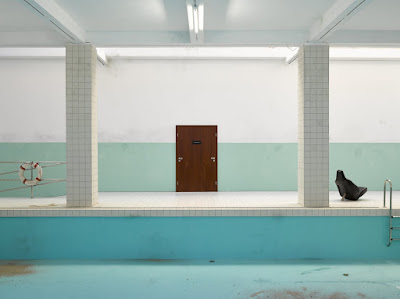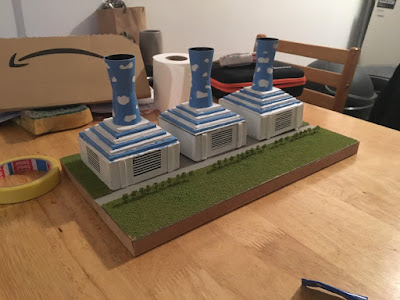Some friends came to visit us in London for Christmas so we did some fun tourist-y art galleries with them. Starting off at Tate Modern we managed to catch what must be the final few days of Olafur Eliasson’s giant (although not so giant anymore) blocks of glacier. Overall, it’s fairly underwhelming; if the point is to confront the general public with the dangers of climate change then this is a pretty luke-warm attempt. This isn’t shocking imagery, it’s big bits of ice. Much more enjoyable are the photos of them dragging them out of the sea and all the disclaimers about how it’s not actually that bad for the planet to fly 80 tonnes of frozen water half way around the world…
Eliasson also has a new work in the tanks, this one much subtler. Titled ‘Your Double-Lighthouse Projection’ it involves two circular rooms, one is filled with coloured light and the other with white light. The coloured room is quite nice (nice being the key word); the changing light washes over you and it’s all very pleasant but that’s where it all ends really. Niceness.
Susan Philipsz was in another one of the tanks with a sound installation. The room is very dark with only a few dull spotlights. The ideas around the work are quite poetic; it centres on two figures that share the name ‘Lucia’ – the Italian patron saint of the blind, Santa Lucia and the dancer, Lucia Joyce. The name Lucia originates from the Latin word for light – ‘lux’ and in Sweden, the festival of Santa Lucia celebrates the coming of light on one of the darkest days of the year. While shrouded in darkness, you hear Philipsz’s voice singing three songs. The first is Will Oldham’s duet, I See a Darkness, which gives the installation its name. This is followed by Maurice Ravel’s piano piece, Pavane for a Dead Princess, which Lucia Joyce danced to with the group Les Six de rythme et couleur. The work finishes with the four-part Neapolitan folk song, Santa Lucia. This all feels very intentional and in turn gives the work some depth.
Next up we went over to Tate Britian (the other Tate) and saw Monster Chetwynd’s new commission. It’s two giant, illuminated leopard slug sculptures each over 10 metres long. They are accompanied by swathes of blue and white LED slug trails across the building’s façade, so we would recommend going when it’s dark to get the full effect. It’s quite fun and is accompanied by a film of the mating ritual in the foyer.
Once inside we saw the Jesse Darling show ‘The Ballad of Saint Jerome’. The basis for the exhibition is the story of Saint Jerome who was confronted by a ferocious lion and instead of reacting in fear, he recognised that the animal was injured and removed a thorn from its paw. Now tamed, the lion became his lifelong companion. A lovely catalyst for art-making and one which appears to have worked well. Our favourite works were the cowering cabinets with their bent legs, unable or unwilling to support their own weight now that the pages in the binders they’re carrying have been replaced by concrete blocks. All the works have this sense of being pained; some with plasters some with crutches, they’ve all got their own trauma.
Finally, we went to Saatchi to see the Black Mirror exhibition since the new film is coming out soon. It was pretty disappointing due to an excess of boring paintings but was saved by two artworks, one by James Howard which was an entire wall of spam that you might be familiar with if you frequent any film streaming websites. They’re the ones that frame a video link bragging about their latest fix or warning of early symptoms. We weren’t sure about the whole wall aspect and thought that perhaps that would work better if they were positioned as one would find them on a web page but without that context. We’re being picky now but that’s only because we enjoyed the concept.
The other piece was called ‘Cash Cow’ and was by Jade Townsend. The work depicts a sort-of convincing set of male legs holding a red painting with faded/semi-comprehensible statements about sex and smutty acts; a slow-burning critique of gender imbalance and contemporary worth, if one is to put in the time looking. With a title like ‘Cash Cow’, it’s hard to deny that some rather large bones are being picked. Townsend’s sculpture sets its sights on an ‘exclusive’ target – the art market, institution, and the ‘sub-world’ each of them operates within. A fun looking work with a message.

















































